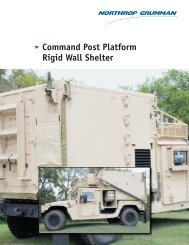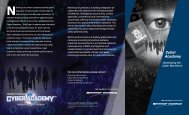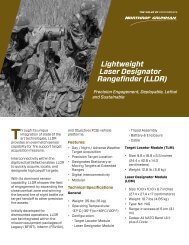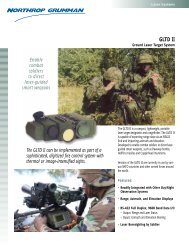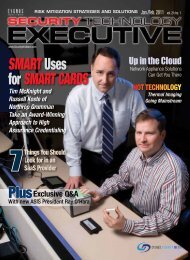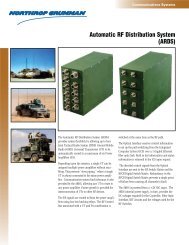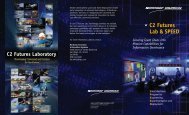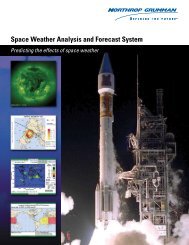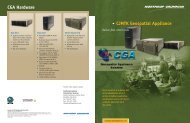Technical Note #18 - Laser Pulse Train Amplification with ...
Technical Note #18 - Laser Pulse Train Amplification with ...
Technical Note #18 - Laser Pulse Train Amplification with ...
You also want an ePaper? Increase the reach of your titles
YUMPU automatically turns print PDFs into web optimized ePapers that Google loves.
Northrop Grumman Cutting Edge Optronics<strong>Technical</strong> <strong>Note</strong> <strong>#18</strong><strong>Laser</strong> <strong>Pulse</strong> <strong>Train</strong> <strong>Amplification</strong><strong>with</strong> PowerPULSE TM ModulesHigh peak power optical pulses are very desirable in industrial, scientific, and military applications. However, maximumpeak powers are limited by the damage threshold of the optical materials used and the amount of amplification available.While pulse-pumped amplifiers can achieve high gains, they are typically limited in total average power. Practical pulsetrains contain pulses that are 10s of picoseconds in width, repeat every microsecond or faster, and have pulse burstslasting 1-5ms or longer. Under these conditions a higher average power is needed to sustain the amplification of thepulse train.Northrop Grumman Cutting Edge Optronics has developed a line of laser amplifiers that have the high gain of the pulsepumped amplifiers, and can maintain the amplifier gain for 1-5ms. This allows the amplification of long pulse trainsusing fewer devices, less gain material, and lower overall cost.© 2011 Northrop Grumman Systems Corporation – All Rights Reserved
<strong>Laser</strong> <strong>Pulse</strong> <strong>Train</strong> <strong>Amplification</strong> <strong>with</strong> PowerPULSE TM ModulesG. Jay Doster, Ph.D. and Ryan Feeler, Ph.D.Northrop Grumman Cutting Edge Optronics, 20 Point West Blvd., St. Charles, MO USA 633011. INTRODUCTIONMany laser applications require very high peak powers at high repetition rates. The pulses are typically generated frommode-locked laser oscillators, fiber laser oscillators, or modulated CW fiber lasers. Amplifying these pulses to useablepeak powers can be challenging as the typical seed laser sources require gains of 30dB or more. In order to obtain highgains in laser amplifiers, high pump powers are required. Continuous operation at high pump powers can limitoperational lifetime of the amplifiers and can fracture the gain medium in extreme circumstances. Operation of theamplifiers in quasi-CW mode allows high pump powers <strong>with</strong>out the negative thermal effects seen in the CW pumpedcase.Northrop Grumman Cutting Edge Optronics (NGCEO) has developed a line of laser amplifiers specifically for highenergy,quasi-CW operation. The PowerPULSE TM laser amplifiers can operate at high pump powers for pumping timeson the order of milliseconds. This allows high amplification factors over longer times at lower thermal loads than isavailable <strong>with</strong> flash lamp pumped systems. These amplifiers have been used in a wide range of applications, includingcombustion diagnostics, Optical Parametric Chirped <strong>Pulse</strong> <strong>Amplification</strong> (OPCPA), and fundamental physics andchemistry experiments.If the application allows, the pulses from the seed laser can be chopped into a series of ‘macro-pulses’, each of whichcontains a sequence of optical pulses at the repetition rate of the seed laser. This concept is illustrated in Figure 1.1ms long‘macro‐pulse’2Hz ‘macro‐pulse’repetition rate20ps pulses, at 100MHzrepetition rate, 1000pulses.Figure 1. Diagram of a series of pulse trains repeated at 2Hz. The macro-pulse is the envelope of the series ofoptical pulses from the seed laser source.The optical pulse train illustrated above typically repeats at 1-5Hz <strong>with</strong> the macro-pulse ranging from 1-5ms in length.<strong>Amplification</strong> of these types of pulses requires systems that can operate at high average powers and create largeamplification factors.Modeling of the laser amplifiers is critical for system design. Tradeoffs of amplifier pump time, pump vs. input pulsephasing, multi-pass architectures, and management of the gain between stages can all be simulated. Simulation ofarbitrary pulse trains and amplifiers allows correct system design and minimizes time to ‘first light’. Using a relatively
Since there is now a single pumping event, the model should solve the population equation by integrating from thebeginning of the pump until the first pulse arrives as the amplifier. The pulse removes the amount of stored energy asfound from Equation 4. The pulse is assumed to be short enough that the pumping during the pulse is not considered. Anew value for the population inversion is found from the reduced stored energy. The population equation is integrated<strong>with</strong> the new initial population condition until the next pulse and the entire modeling cycle is repeated for the entirepulse train.Using this simulation architecture, the overall gain of the laser amplifier for the entire pulse train can be predicted andthe pulse to pulse dynamics can be explored. Since each pulse in the train has a ‘memory’ of the previous pulses, thepulse train can have uneven amplification. This effect for unsaturated amplifiers is illustrated in Figure 2.Figure 2. Simulation of a 2 pass pulse train amplification for different phasing of pump and pulse train starts.The pulse train start delay <strong>with</strong> respect to the pump pulse start is 0, 240µs, 420µs, and 1ms for the upper left,upper right, lower left, and lower right figures respectively.The first graph is a simulation of a 20kHz pulse train passing through a small amplifier where the first pulse in the trainarrives at the beginning of the pump pulse. The buildup of the gain can be seen as the pulse train increases in size. Thesecond graph illustrates the results when the pump pulse starts 240µs before the arrival of the first pulse of the train. Inthis case there is stored energy in the first pulse but steady state gain has not yet been achieved. The third graphrepresents the pump pulse preceding the pulse train by 420µs. Since each output pulse has the same energy, the amountof stored energy removed from the laser exactly balances the amount of energy increase due to the pumping betweeneach pulse. The last graph is the results when the pump pulse precedes the pulse train by 1ms. In this case the storedenergy is higher than the preceding cases and the first pulse sees a large gain. The gain is depleted by the first few pulses
at a greater rate than it is replenished by the pump pulse. The phasing of the pump pulse and the pulse train is critical toobtaining constant output energy per pulse.4. APPLICATIONSA typical pulse train amplifier system is illustrated in the Figure 3 below. This system is designed to amplify a modelocked,10ps, 400MHz pulse train that has a macro-pulse duration of 1.2ms. The entire pulse train repeats at 2Hz. Theamplified pulse is designed to be injected into a buildup cavity in order to obtain more than 5MW peak power. The lasersource delivers about 0.5W power in 1ms and has a peak power of about 125W. This equates to 0.5mJ per pulse.500µJ, 10ps, 400MHz, 1.2ms trainSource <strong>Laser</strong>Half wave plateQuarter wave plateRBA20‐1P1HPowerPULSEModuleHigh reflectorIsolatorHalf wave plateREA4006‐1P1HPowerPULSEModule500mJ OutputHigh reflector2x TelescopeFigure 3. <strong>Pulse</strong> train amplifier architecture showing multipass and cascade operation of PowerPULSE modules.(Used <strong>with</strong> permission from Dr. Russell Wilcox, Lawrence Berkeley National Lab.)The first stage, RBA20 amplifier is designed to have a two-pass gain of about 100, or a single-pass gain of 10. After thefirst stage, the beam has about 50W average power (50mJ per pulse). The larger REA4006 amplifier is single-passed foran additional 4x amplification giving 200W output power. The final beam amplification is 400x and the output has200mJ per pulse. The system as described is capable of over 500mJ per pulse when operated at the maximum pumpcurrent limit. In this design the final amplifier is not fully saturated. Another pass of this amplifier would result in anadditional 200mJ of energy.
5. INDUSTRIAL SUITABILITYPowerPULSE amplifiers are based on the same basic design that NGCEO has used for its CW-pumped products for over15 years. The CW modules are manufactured in high volume and are currently being used in thousands of industrialinstallations around the world in a variety of applications, <strong>with</strong> product lifetimes measured in the tens of thousands ofhours.QCW versions of these amplifiers require a higher level of engineering to achieve similar levels of reliability due to thehigh drive currents and the number of laser diode bars in each module. The PowerPULSE amplifiers that are used invery high-energy systems contain multiple laser diode arrays, resulting in a total bar count of between 20 and 300.Example degradation data for an ensemble of laser diode arrays is shown in Figure 4, and represents what would beexpected from a typical PowerPULSE amplifier. Product lifetimes in the tens of billions of shots are typical, and highershot counts are achievable at derated operating currents. Further details of the life test are available in previouspublished work [3].1.2Summed Output Power (arb. Units)10.80.60.40.200 3 6 9 12Shots (Billion)15Figure 4. Life test data of a representative ensemble of QCW laser diode arrays, similar to those used in largePowerPULSE amplifier modules. This data was obtained at drive conditions of 110A, 750Hz, 200μs.
6. CONCLUSIONNorthrop Grumman Cutting Edge Optronics has developed an amplifier module family that can operate for extendedpumping times, on the order of several milliseconds. The longer pump times allow amplification of high repetition ratepulse trains. The high gain, high average power amplifiers – in combination <strong>with</strong> accurate modeling – allow selection ofthe correct amplifier model for the desired output characteristics of the system. Correct time phasing of the pump andpulse train is critical for uniform amplification of the pulse train and is dependent on the system architecture.These amplifiers are based upon proven design principles and contain long-life laser diode bars. As a result, they aresuitable for a wide range of industrial and scientific applications.REFERENCES[1] W. Koechner, “Solid-State <strong>Laser</strong> Engineering”, 5 th Edition, 1999. See especially sections 1.4.2 and chapter 4.[2] Russell Wilcox, Lawrence Berkley National Laboratory, “An H- stripping laser using commercial, diodepumpedNd:YAG amplifiers”, presented at <strong>Laser</strong> Stripping Workshop, April 11, 2011.[3] Feeler, R., Junghans, J., Remley, J., Schnurbusch, D., Stephens, E., "Reliability of high-power QCW arrays,"Proceedings of SPIE Vol. 7583, 758304 (2010). (also available here)
Our Products<strong>Laser</strong> Diode ArraysCEO® offers a full line of conductively cooled, water cooled or microchannel cooled laserdiodes and stacks. Choose from our wide range of standard product offerings including GoldenBullet arrays for long pulse (>500 µs) applications. Wavelengths from 780 – 1550 nm areavailable.CW Pumped <strong>Laser</strong> ModulesOur range of diode modules are an ideal 'pump engine' solution for OEM manufacturers of DiodePumped Solid State (DPSS) lasers. They are available <strong>with</strong> a variety of gain media options(Nd:YAG, Nd:YLF, Nd:YVO 4 etc.). Output powers ranging from 20 W (TEM oo ) to 800 W(multi mode) are available.QCW Pumped <strong>Laser</strong> ModulesFor high energy pulsed laser applications, CEO offers the PowerPULSE family of modules todeliver output energies up to 4 J per pulse and small signal gain in excess of 600. CTE matched,' hard solder' laser diode packaging technology ensures long operating lifetimes.Electronics & Support EquipmentChoose from CEO’s complete line of proven and versatile OEM high powered diode drivers andlaser system controllers along <strong>with</strong> all the support equipment needed to operate high power CWand QCW pump modules or other diode-based laser systems.Industrial <strong>Laser</strong> SystemsCEO offers industrial laser systems for micro-machining, marking, cutting, drilling, welding,soldering, and other industrial uses. These lasers utilize long-life diode pump sources to enablelong laser lifetimes. Custom lasers can be built to a wide range of specifications.Military & Custom <strong>Laser</strong>sCEO ® offers complete custom laser design engineering and manufacturing services of diodepumped solid state lasers (DPSS), laser diode arrays and modules for military, aerospace andindustrial OEM laser applications. CEO specializes in engineering systems that are required tooperate in harsh rugged environments including military & civilian helicopters, fixed wingaircraft, ground vehicles, and submerged towed bodies.Contact UsTelephone: 636.916.4900Fax: 636.916.4994st-ceolaser-info@ngc.com20 Point West Boulevard, St. Charles, MO ( USA), 63301http://www.as.northropgrumman.com/businessventures/ceolaser/index.html


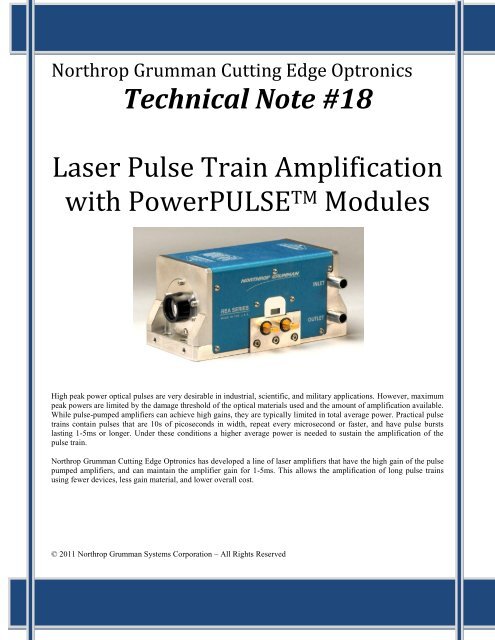
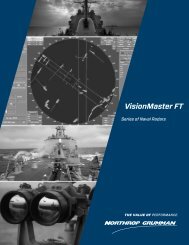
![[x] amendment of solicitation/modification of contract - Northrop ...](https://img.yumpu.com/51622731/1/190x245/x-amendment-of-solicitation-modification-of-contract-northrop-.jpg?quality=85)
